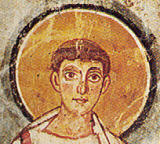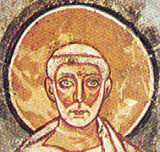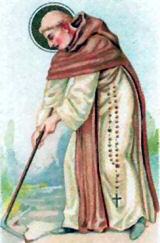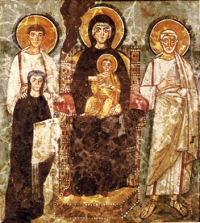Make your gift today!
Help keep Catholics around the world educated and informed.
Already donated? Log in to stop seeing these donation pop-ups.
Ordinary Time: August 30th
Wednesday of the Twenty-First Week of Ordinary Time; St. Jeanne Jugan
Other Commemorations: Saints Felix and Adauctus, Martyrs (RM); St. Fiacre, Hermit (RM)
» Enjoy our Liturgical Seasons series of e-books!
Today is the feast of St. Jeanne Jugan, in religion St. Mary of the Cross (1792-1879), foundress of the Little Sisters of the Poor.
Sts. Felix and Adauctus were two Roman martyrs under the Diocletian persecution. They are buried in the cemetery of Commodilla at the gates of Rome on the Ostian Way. St. Fiacre, who is in the Roman Martyrology, is from the diocese of Meaux and is the patron saint of gardeners. According to the Tridentine Calendar today is the feast of St. Rose of Lima. The General Roman Calendar now celebrates her feast on August 23.
Sts. Felix and Adauctus
 In the year 304 Felix was living piously and happily, doing the work of a Christian priest in Rome, when he was captured, along with many other Christians at the start of the persecutions under the Emperor Diocletian. First he was savagely tortured. Then he was sentenced to be beheaded, for no torture sufficed to make him give up his Christian beliefs.
In the year 304 Felix was living piously and happily, doing the work of a Christian priest in Rome, when he was captured, along with many other Christians at the start of the persecutions under the Emperor Diocletian. First he was savagely tortured. Then he was sentenced to be beheaded, for no torture sufficed to make him give up his Christian beliefs.
Felix was led to the place of execution. So noble and apparently unconcerned did he seem at the prospect of imminent death that one of the crowd who had so far kept secret his own Christianity, shouted out: 'I too follow and believe the same commandments that this man confesses. I too follow and believe in the same Jesus Christ. And I too will give away my life to further his cause.'
 The Roman soldiers rushed to seize the man, and he too was beheaded alongside Saint Felix. Unfortunately no-one even gathered his name. He was therefore dubbed 'Adauctus', which simply means 'the additional one.'
The Roman soldiers rushed to seize the man, and he too was beheaded alongside Saint Felix. Unfortunately no-one even gathered his name. He was therefore dubbed 'Adauctus', which simply means 'the additional one.'
Both martyrs were reverently buried in the cemetery of Commodilla on the Ostian Way. By the time the list of martyrs known as the Depositio Martyrum was compiled in the year 354, they were simply known as 'Felix and Adauctus.'
About thirty years later Pope Damasus ordered that their tomb be restored and he put an inscription over it.
—Excerpted from A Calendar of Saints by James Bentley
Highlights and Things To Do:
- Learn more about Felix and Adauctus:
- There is an ancient devotion to these early Roman martyrs. There is an amazing exhibit in Krakow of the Lost Wawel from the 10th-11th century rotunda church dedicated to St. Felix and Adauctus.
- And how about a little bit of science from this archeology exhibit?
- See the painting The Glorification of Saints Felix and Adauctus (1759–61) by Carlo Innocenzo Carlone (1686–1775).
- It's not the Rosetta Stone, but in the tomb of Saints Felix and Adauctus in the catacombs of Commodilla in Rome there is a cornice of a fresco that the Christian inscription/graffiti has an important place in the history of the Italian language.
St. Fiacre
 St. Fiacre (also known as Fiachra; Fiachrach; Fiacrius; Fiaker and Fevre) was a hermit at Kilfiachra, Ireland. He left to go to France, and then lived as a solitary at Breuil, Brie, on land given him by St. Faro, bishop of Meaux. Fiacre built a hospice for travelers, attracted many disciples, was known for his charity and aid to the poor, and was consulted by many for his spiritual wisdom. His miracles of healing became legendary. He is the patron saint of gardeners and the cabdrivers of Paris, whose vehicles are called fiacres, since the first coach for hire in Paris was located near the Hotel Saint-Fiacre. He is mentioned in Roman Martyrology for this day.
St. Fiacre (also known as Fiachra; Fiachrach; Fiacrius; Fiaker and Fevre) was a hermit at Kilfiachra, Ireland. He left to go to France, and then lived as a solitary at Breuil, Brie, on land given him by St. Faro, bishop of Meaux. Fiacre built a hospice for travelers, attracted many disciples, was known for his charity and aid to the poor, and was consulted by many for his spiritual wisdom. His miracles of healing became legendary. He is the patron saint of gardeners and the cabdrivers of Paris, whose vehicles are called fiacres, since the first coach for hire in Paris was located near the Hotel Saint-Fiacre. He is mentioned in Roman Martyrology for this day.
—Excerpted from Dictionary of Saints, John J. Delaney
Patronage: against barrenness; against blindness; against colic; against fever; against fistula; against haemorrhoids or piles; against headache; against sterility; against syphilis; against venereal disease; sick people; box makers; brass workers; cab drivers; coppersmiths; florists; gardeners; hat makers, cap makers; harvests; hosiers; lead workers; needle makers; pewterers, pewtersmiths; potters; taxi drivers; tile makers; trellis makers; Saint-Fiacre, Seine-et-Marne, France
Symbols and Representation: Spade and open book; rosary; birds; spade; shovel
Often Portrayed as: man carrying a spade and a basket of vegetables beside him surrounded by pilgrims and blessing the sick; Benedictine monk with a shovel; Benedictine monk with a heavy staff interceding for sick people; Benedictine monk with pilgrims; Benedictine monk with a basket of vegetables
Highlights and Things to Do:
- Learn more about St. Fiacre:
- Read St. Fiacre, Patron Saint of Gardeners and St. Fiacre, the Gentle Gardener.
- See the 15th century French chapel, La Chapelle Saint Fiacre.
- Pray the Prayer for the Feast of St. Fiacre.
- Despite the many images of St. Fiacre that depict him wearing Franciscan robes, Fiacre was not a Franciscan. He was a hermit, and not attached to a particular religious order.






